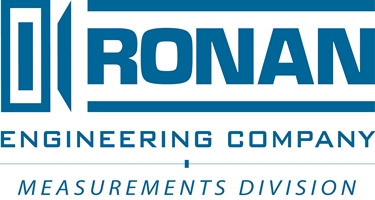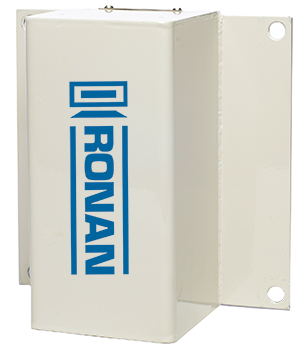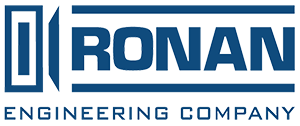Radiation Low Level Source Holder
RLL is a Ronan Engineering term that stands for “Radiation Low Level.” RLL technology utilizes up to a total of 0.9 mCi (0.33 GBq) of cesium source. In comparison, some conventional density gamma gauges use source sizes with a hundred times more activity to make the same measurement. Because of these very low-levels of activity, and their simplicity of design, Ronan systems are the safest gamma gauges on the market. The NRC recognized this in 1999 when Ronan Engineering attained certification for the first RLL source design.
Three types of RLL Source Holders: the RLL-1, RLL-1A, and RLL-2:
- RLL-1: (1) one to (10) ten 0.09 mCi (0.003 GBq) cesium capsules
- RLL-1A: single 0.90 mCi (0.03 GBq) cesium capsule
- RLL-2: strip source holder which accommodates up to a total of 100 µCi (0.004 GBq) cesium 137
The RLL-1 and 1A are very similar in that neither require:
- Periodic shutter check. Per NRC guidelines, shutters are not required on source holders with less than 1 mCi (0.037 GBq) of cesium.
- No Radiation Safety Officer and/or Special Radiation Training is required by NRC
- No licensed radiation personnel is required to install, commission or move on-site
Other advantages include:
- 0.5 mrem/hr @ 12″
- Lower disposal cost than conventional, higher intensity type gauges
- Lead free option available
- Fire resistant design available
- Less risk to users
- Less documentation to maintain
RLL is a Ronan Engineering term that stands for “Radiation Low Level.” RLL technology utilizes up to a total of 0.9 mCi (0.33 GBq) of cesium source. In comparison, some conventional density gamma gauges use source sizes with a hundred times more activity to make the same measurement. Because of these very low-levels of activity, and their simplicity of design, Ronan systems are the safest gamma gauges on the market. The NRC recognized this in 1999 when Ronan Engineering attained certification for the first RLL source design.
Three types of RLL Source Holders: the RLL-1, RLL-1A, and RLL-2:
- RLL-1: (1) one to (10) ten 0.09 mCi (0.003 GBq) cesium capsules
- RLL-1A: single 0.90 mCi (0.03 GBq) cesium capsule
- RLL-2: strip source holder which accommodates up to a total of 100 µCi (0.004 GBq) cesium 137
The RLL-1 and 1A are very similar in that neither require:
- Periodic shutter check. Per NRC guidelines, shutters are not required on source holders with less than 1 mCi (0.037 GBq) of cesium.
- No Radiation Safety Officer and/or Special Radiation Training is required by NRC
- No licensed radiation personnel is required to install, commission or move on-site
Other advantages include:
- 0.5 mrem/hr @ 12″
- Lower disposal cost than conventional, higher intensity type gauges
- Lead free option available
- Fire resistant design available
- Less risk to users
- Less documentation to maintain


RLL-1 does not require a Leak Test. RLL-1A requires a Leak Test very three years.
Ronan sizes the source to last a minimum of 15 years, usually 20-30 years. Our goal is to provide a minimum of 15 years of service on all source.
Documents:
Cost of Ownership
Even though the initial equipment cost may be approximately 20% higher than conventional gamma gauges, the return on investment is almost immediate. The differential in equipment costs are offset by lower installation costs (RLL sources do NOT require licensed personnel to install, service or commission at their registered location… conventional source holders require licensed personnel). On-going maintenance costs are also lower as the RLL does NOT require periodic leak tests (RLL-1) or shutter checks as conventional sources do.
- The RLL Type Gauge is Approximately 100 lbs (45 kg), Lighter Than Conventional Type Gamma Gauges and as Such are Easier to Install…No Supports Required on Smaller, Lighter Piping
- The RLL is Smaller in Overall Dimensions (6 in, 15 cm) Than Conventional Type Gamma Gauges
- Dependable, Reliable, Repeatable Measurement That is Easy to Install, Calibrate and Maintain
Ronan can utilize low-level technology because our only focus is on non-contact measurement gauges. We use scintillation type detectors. We cut and polish the crystals at our facility. We utilize spring pressure to hold the crystal securely to the photo-multiplier tube. We do not use cements, glue or grease that can degrade or break the connection between the crystal and photo-multiplier tube. Ronan typically uses larger crystal sizes, which enables us to measure a larger sample of the product in the pipe. Ronan’s microprocessor utilizes the latest technology in the industry.
About
For more than 60 years, Ronan Engineering has manufactured reliable and leading-edge instrumentation systems. As providers of real-time monitoring and measurements of critical process control points, Ronan has kept some of the world’s largest plants, factories, hospitals and facilities running safely and efficiently. Ronan has established manufacturing, sales and service facilities in Kentucky and the United Kingdom.
